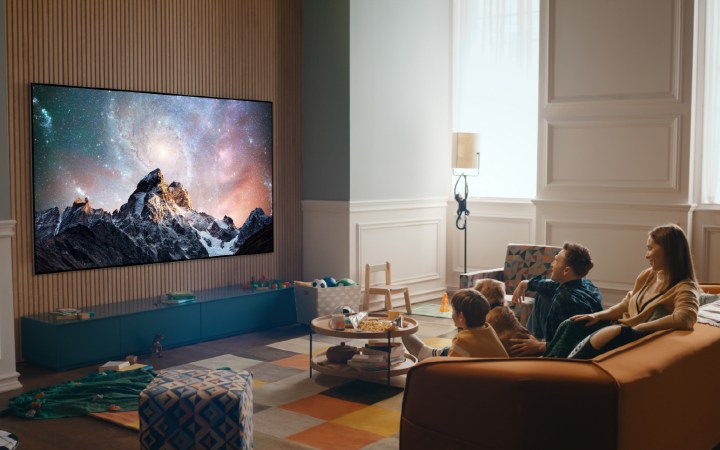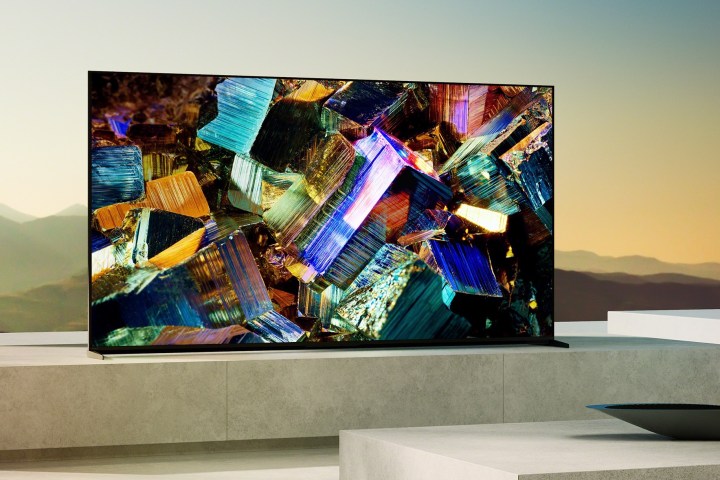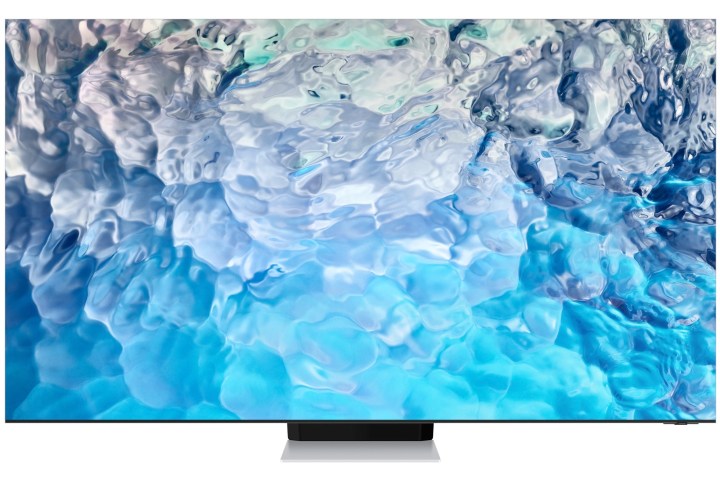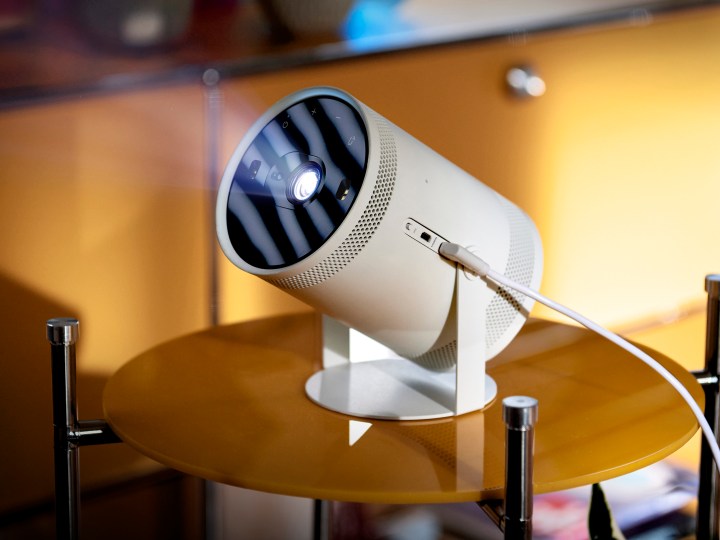The annual Consumer Electronics Show is a great event to see all of the hot new tech that will be changing our lives in the years to come, but at its core, it’s still very much the preeminent event for checking out what TV makers have in store for us. CES 2022 was no exception, and because of a groundbreaking new display technology — QD-OLED — it may well turn out to be one of the most important CES shows in years. What did we see that was most exciting while at the show, and what can you expect to find in stores this year? Here are the best TVs of CES 2022.
LG Gallery Series G2 OLED TVs

Since the LG G1 Gallery Series OLED earned our top spot for most of 2021 in our best TVs roundup, it’s only fair that we start this list with its replacement, the Gallery Series G2. What’s changed? LG’s flagship nonrollable TV is now bigger, better, and brighter. How can you go wrong with that?
For one thing, LG now gets to claim that it has the largest OLED TV you can buy. The G2 comes in several sizes — 55-, 65-, and 77-inches, plus there’s a new 83-inch model. But if you want to go really big, give your bank manager a call because the G2 is also going to come in an absolutely massive 97-inch size, too. If you have to ask how much it will be …
Regardless of which size you opt for, LG promises the G2 will be even brighter than the 2021 OLED evo-based G1 — which was already a step up from LG’s prior panels. The company hasn’t said just how much brighter the G2 will be, but it did say that the TV uses new components that let it maintain that extra brightness for longer periods.
Design-wise, the G2 is thinner (how that’s possible we’re not sure) and possesses even smaller bezels than the G1. And folks who thought that LG’s optional legs didn’t match the care and attention that went into making the G1 will be pleased (or envious) to know that the G2 gets a much more attractive optional stand in case you don’t want to use the included wall mount.
Read our full report on LG’s CES 2022 TVs
Sony Master Series A95K QD-OLED 4K TV

In case you’re just getting up to speed with all the news from CES 2022, let us tell you the only thing you need to know (at least as far as TV tech is concerned): QD-OLED TVs are real, they bring together the best of QLED and OLED into a single panel, and they are amazing. We say that with confidence after having seen a live demo at the show, courtesy of Samsung Display, the only company so far that manufacturers the QD-OLED hybrid panels (which also go by the name “QD Display”). Dazzlingly bright, with superb viewing angles, and all of the inky black goodness we’re used to from OLED, we don’t yet know how much an QD-OLED TV will cost, but do we know you’re going to want one.
And the first QD-OLED TV you’ll be able to buy is Sony’s new Master Series A95K, a Google TV-powered, 4K-resolution QD-OLED TV that will come in 55- and 65-inch sizes when it formally debuts later this year. We haven’t seen the A95K in person, but based on the Samsung Display demo, and what we know of Sony’s capabilities when it comes to image processing, we have zero doubts that this TV will be a stunner in every way.
And just in case QD-OLED isn’t enough of a reason to think highly of the A95K, Sony has packed it full of other leading-edge tech, including full support for HDMI 2.1: eARC, 4K@120Hz, variable refresh rate (VRR), auto low-latency mode (ALLM), and 48Gbps bandwidth. Sony has improved its Acoustic Surface Audio+, which turns the entire screen into a speaker, powered by two full-range drivers and two subwoofers, and every A95K includes Sony’s new Bravia Cam. That camera — which has its own physical privacy switch — enables video calling, sound and image optimization based on viewer positions, energy saving, gesture controls, and even a warning when kids stand too close to the TV.
Finally, let’s take a moment to appreciate the stand. It may not look like it’s remarkable, but it gives you two positions. A forward position that reduces the stands appearance to a thin stripe, and a backward position that lets you get the screen nearly flush to the wall behind it. Needless to say, we can’t wait to get the A95K into our labs for its first tests.
Read our full report on Sony’s A95K QD-OLED TV
Sony Master Series Sony Z9K mini-LED 8K TV

This year is apparently going to be a big one for Sony’s TV ambitions. Not only will it be introducing its first model based on QD-OLED technology, but also its first TVs with mini-LED backlighting. Sony will be adding mini-LEDs to its X95K — its top-of-the-line 4K LED TV, — but for the sake of this list, it’s the 8K flagship Master Series Z9K that has us drooling.
We’ve already seen how mini-LEDs can substantially improve contrast control and black levels in TVs like TCL’s 6- and 8-Series, Samsung’s Neo QLED models, and LG’s QNED models, but Sony is promising that none of these will compare to its mini-LED TVs. As evidence for this claim, Sony is offering two of its premier technologies: Cognitive XR Processor (now in its second version) and its XR Backlight Master Drive.
In Sony’s opinion, mini-LED backlights are a huge improvement over older LED systems because of their smaller size (thousands of mini-LEDs versus hundreds of LEDs) and greater zone-based lighting control, but it also maintains that these advantages can be held back if a TV’s image processing and backlight control aren’t up to the task of extracting the full potential of mini-LED. Needless to say, Sony believes it can do a better job and, based on its track record with its previous LED and OLED TVs, we are going to give it the benefit of the doubt.
The Z9K runs Google TV and will come in 75- and 85-inch screen sizes. Like the A95K, it boasts a full set of HDMI 2.1 capabilities, including 8K@60Hz, and Sony’s new Bravia Cam. Hands-free voice commands work through the embedded microphones, and Sony’s new premium remote control is backlit, easy to clean, and can be located when lost by saying, “OK Google, where’s the remote?”
Read our full report on Sony’s mini-LED TVs
TCL X9 ODZero mini-LED 8K TV

TCL technically debuted its flagship 8K TV, the X9, in fall 2021, but the company chose to make CES 2022 its official coming-out party. Technologically and design-wise, it’s glorious, but you’ll pay a hefty $10,000 for the pleasure of owning this 85-inch 8K TV when it’s finally available later this year.
What makes the X9 stand out from the crowd — other than its avant-garde stand and integrated 5.1.2 Onkyo-powered Dolby Atmos soundbar — is TCL’s “ODZero” mini-LED backlight, which makes the X9 the first non-OLED TV to achieve OLED-like thinness. The screen is only 10 millimeters thick, about the width of an iPhone 11.
The slick-looking stand can pull off a transformation that even an Autobot would envy, taking the X9 from tabletop to wall-mount, including a reorientation of the soundbar from horizontal to vertical.
Powered by Google TV and packing a pop-up webcam for video calls, the X9 also has the kind of feature list you’d expect in a TV of this price: Dolby Vision, Dolby Vision IQ, Dolby Atmos, HDMI 2.1 with VRR, ALLM, 4K@120Hz, and eARC. Hands-free voice with Google Assistant is also available, as is Chromecast built-in and Apple AirPlay 2.
It’s possible that TCL has neglected to put everything into this TV, but from what we know so far, we think that possibility is slim at best.
Read more about the TCL ODZero X9 and its other CES 2022 TVs
Hisense U9H ULED 4K mini-LED TV

Since Hisense unveiled its first 8K TV in December — the 75-inch U800GR Roku TV — the company decided to focus on on its 4K range during CES 2022. The new flagship for that lineup is the the U9H, a 75-inch Google TV-powered model that will be available late summer 2022 for $3,200. It’s the company’s first mini-LED TV and it’s not messing around: With more than 1,280 full-array local dimming zones and up to 2,000 nits of peak brightness, it’s going to be a scorcher that just might rival OLED in terms of black levels and contrast.
Those specs make us think Hisense may have given up on its dual-cell technology, which was supposed to accomplish similar results, but fell short of expectations in our review.
Hisense claims its ULED technology takes advantage of the benefits of mini-LED by enabling a “seamless relationship” between hardware and software, which apparently produces enhanced color, contrast, motion, and brightness. An upgraded processor can perform automatic adjustments in real time, continuous scene-by-scene modifications, and fine-tuning of each frame at a pixel level, while the 120Hz native refresh rate provides smooth clarity and motion handling.
The U9H isn’t shy on premium features: It incorporates quantum dots into the backlight for better color accuracy, and it supports Dolby Vision, Dolby Vision IQ, HDMI 2.1 options like eARC, ALLM, Game Mode Pro, VRR, and support for AMD’s FreeSync.
The U9H also has an upgraded built-in sound system with speakers embedded in both the top and bottom of the TV for a 2.1.2 surround sound configuration. Along with Dolby Atmos, Hisense has also include support for the WiSA wireless speaker platform on the U9H and several of its other 2022 ULED TVs.
Read our full report on Hisense’s CES 2022 TVs
2022 Samsung Neo QLED 8K

Samsung didn’t announce an actual new TV model at CES, but it did showcase all of the new technologies that will be appearing on its Neo QLED range. The first of these is its Neo Quantum Processor, which brings advanced contrast mapping via better control over its mini-LED backlight. It increases brightness levels from 12- to 14-bit gradation,for a huge jump in fine-tuned brightness control: 16,384 steps versus the previous 4,096 steps. We’re very curious to see how this performs once we get a chance to try it in non-show conditions.
Shape Adaptive Light technology can analyze lines, shapes, and surfaces, letting the backlight do a more accurate job of rendering all shapes, which Samsung says will greatly improve HDR performance. A new picture quality algorithm helps the TV better understand foregrounds and backgrounds so it can create a greater sense of depth and realism.
One of OLED’s stated advantages over QLED TVs is its low blue light emissions — something that can adversely affect eye health and sleep patterns. The 2022 Neo QLED models use a new EyeComfort mode, which goes further toward addressing this problem by automatically adjusting the screen’s brightness and tone based on a built-in light sensor and sunset/sunrise information. It then uses this info to reduce blue light levels toward the evening hours — something we’ve seen on computers and smartphones from Apple.
Sound is improved as well, with a new version of Samsung’s OTS (Object Tracking Sound) called OTS Pro. It uses up-firing speakers to create overhead surround sound for a Dolby Atmos experience that doesn’t require a separate soundbar. From a user experience point of view, Samsung is adding three new “hubs” to its Tizen OS, letting you focus in on specific activities like streaming media, gaming, or choosing an ambient display for when you’re not active watching content. On that last item, Samsung is jumping on the NFT art trend by giving its users a way to “browse, purchase, and display your favorite art.”
Finally, Samsung has devised a new remote for its TVs, one that can harvest energy from a variety of sources including solar and radio frequencies, and thus never needs to be charged or have its batteries swapped out.
Read our full report on Samsung’s CES 2022 TVs
LG 42-inch C2 Series OLED TV

We’ll keep this one short and sweet: OLED TVs have already proven themselves as the ultimate gaming displays thanks to their near-instant response times. When you couple this with LG’s impressive commitment to the newest HDMI 2.1 specs, like full bandwidth 48Gbps, VRR, ALLM, 4K @ 120Hz, and additional gaming goodies like HGiG, AMD FreeSync, and Nvidia G-Sync, it’s hard to think how they could be better gaming companions.
Except the size. As glorious as gaming on a big, 65-inch OLED TV is, some folks need something considerably smaller. And while a 42-inch TV is still huge by desktop standards, it’s small enough that it can do double duty as both a TV and a gaming monitor, something very few TVs can claim.
And since the 2022 LG C2 OLED series will be equipped with the same OLED evo panel that the G1 series got in 2021, they’ll also be among the brightest displays you can buy.
Read our full report on LG’s CES 2022 TVs
Honorable mention: Samsung Freestyle

Nope, it’s not a TV, and you’d be right for questioning why this odd-looking device is on our best TV list. But we felt Samsung’s $899 projector-masquerading-as-a-spotlight Freestyle deserved a special mention if for no other reason than it gets right what so many other toylike portable projectors get wrong.
It has great built-in speakers (including a tiny 5-watt, 360-degree woofer) — an area that is always overlooked on these devices — and you can power it from a USB-C connection, which means your computer or even a portable power bank can be used.
With a suite of onboard sensors, the Freestyle can quickly, accurately, and automatically correct its projected image so that no matter where you place the projector relative to the wall or screen, you’ll get a straight, uniform picture.
It also has Samsung’s Tizen OS with both Amazon Alexa and Samsung Bixby built-in for voice control, letting you play a movie, listen to music, or get information with your voice. All of the usual streaming apps are here including Netflix, Amazon Prime Video, etc.
And even though its 1080p Full HD resolution is no match for today’s 4K or even 8K TVs, it does do HDR from its 550 lumen LED light source.
But what really sets the Freestyle apart is its weird and wacky optional accessories, like an E26 light bulb power connector, a waterproof case, colorful skins, and a rechargeable battery base for fully wireless operation. So no, the Freestyle is not a TV, but it might the most fun way to watch TV that we’ve seen in a long time.
You’ll be able to pre-order the Freestyle in the United States starting on January 4.



